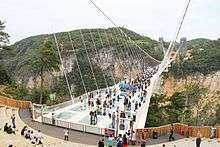Zhangjiajie Glass Bridge
| Zhangjiajie Glass Bridge | |
|---|---|
 | |
| Coordinates | 29°23′55″N 110°41′54″E / 29.3987°N 110.6982°ECoordinates: 29°23′55″N 110°41′54″E / 29.3987°N 110.6982°E |
| Carries | Footbridge |
| Locale | Zhangjiajie, Hunan, China |
| Characteristics | |
| Design | Suspension |
| Material | Steel |
| Width | 14 m (46 ft) |
| Height | 360 m (1,180 ft) |
| Longest span | 430 m (1,410 ft) |
| Clearance below | 260 m (850 ft) |
| History | |
| Opened | August 20, 2016 |
| Statistics | |
| Daily traffic | 8,000 |
| Zhangjiajie Glass Bridge | |||||||
| Traditional Chinese | 張家界大峽谷玻璃橋 | ||||||
|---|---|---|---|---|---|---|---|
| Simplified Chinese | 张家界大峡谷玻璃桥 | ||||||
| Literal meaning | Zhangjiajie Grand Canyon Glass Bridge | ||||||
| |||||||
| Official Chinese stylized name | |||||||
| Traditional Chinese | 雲天渡 | ||||||
| Simplified Chinese | 云天渡 | ||||||
| Literal meaning | Cloud Sky Crossing | ||||||
| |||||||
Zhangjiajie Glass Bridge is a bridge in Zhangjiajie, China, above the Wulingyuan area. The bridge, built as an attraction for tourists, is glass-bottomed and is transparent. When it opened it was the longest and tallest glass bottomed bridge in the world. The bridge, opened to the public on August 20, 2016, measures 430 metres in total length and 6 metres in breadth, and is suspended about 260 metres above the ground.[1] The bridge spans the canyon between two mountain cliffs in Zhangjiajie National Forest Park in China's central Hunan province. It is designed to carry up to 800 visitors at a time. The bridge was designed by Israeli architect Haim Dotan.[2]
To build the bridge, engineers erected 4 support pillars on the edges of the walls of the canyon. The bridge is made of a steel frame with more than 120 glass panels. Each of these panels is 3-layered and is a 2-inch-thick slab of tempered glass. There are 3 long swings attached to the underside of the bridge. Also there is a provision for making a 265 metre bungee-jump. This is considered to be highest such jump in the world.[3]
According to the Management Committee of the Bridge, the bridge has set ten world records spanning its design and construction.[4]
The record as longest glass bridge has since passed to a glass bridge in the Hongyagu Scenic Area, Hebei.[5]
Closure and reopening
On September 2, 2016, just 13 days after the bridge was opened, the authorities put out a notice saying that they are closing the bridge due to overwhelming visitor traffic.[6] The bridge, designed to hold 800 people at a time and expected to be visited by about 8,000 people per day, had reportedly attracted more than 80,000 visitors per day.[7] The authorities said that the government decided to suspend operations due to the "urgency to improve and update" the attraction, including its car parks, ticket-booking system, and customer service. The bridge reopened on September 30, 2016.[8]
See also
References
- ↑ "World's tallest and longest glass bridge closes after just two weeks". Dezeen. 2016-09-05. Retrieved 2018-01-21.
- ↑ "World's longest glass suspension bridge has an intentional wobble". Dezeen. 2018-01-19. Retrieved 2018-01-21.
- ↑ Grennan Milliken. "China is Building the longest and highest glass bridge in the world". Popular science. Retrieved 15 November 2016.
- ↑ "World's longest, highest glass bridge to open". Xinhuanet. Retrieved 16 November 2016.
- ↑ 王建芬. "World's longest glass bridge ready to open - Chinadaily.com.cn". www.chinadaily.com.cn. Retrieved 2017-12-26.
- ↑ Chris Graham (3 September 2016). "China's record-breaking glass bridge closes after 13 days 'due to overwhelming demand'". The Telegraph. Retrieved 16 November 2016.
- ↑ Nick Mafi. "Why Did the Zhangjiajie Grand Canyon Glass Bridge Suddenly Close?". Architectural Digest. Retrieved 16 November 2016.
- ↑ "World's highest glass bridge to reopen after one-month overhaul". Xinhuanet. Retrieved 11 August 2017.